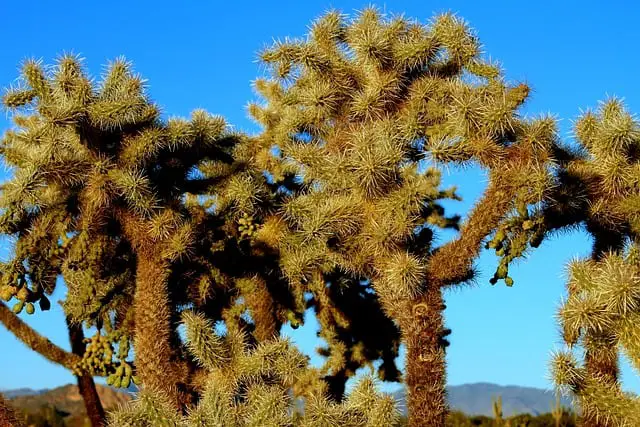The cholla tree, also known as the jumping cholla or the teddy bear cholla, is a type of cactus that belongs to the Cactaceae family. It is native to the southwestern regions of the United States and parts of Mexico.
Cholla wood has a number of commercial uses which we’ll discuss below along with an overview of the wood itself.
Let’s get started!
10 Interesting Facts About The Cholla Tree
If you’re unfamiliar with the cholla tree, here are 10 interesting facts about it:
- Cholla trees belong to the Cylindropuntia genus, which includes about 20 different species of cacti.
- The name “cholla” comes from the Spanish word “choya,” which means “thorny cactus.”
- Cholla trees have adapted to survive in extreme desert environments by storing water in their thick, fleshy stems.
- The spines or glochids on cholla trees are modified leaves and serve as a defense mechanism against herbivores. They detach easily and can cause irritation if touched.
- Cholla trees are known for their distinctive segmented stems, which easily break off and can take root to form new plants through a process called vegetative propagation.
- Some species of cholla trees have beautiful and vibrant flowers that bloom in various colors, including shades of pink, purple, and yellow.
- Cholla trees provide important habitat and nesting sites for birds, including owls, woodpeckers, and cactus wrens.
- Certain species of cholla, such as the teddy bear cholla, have gained the nickname “jumping cholla” because their spines can seemingly “jump” onto passing animals or unsuspecting individuals due to their barbed nature.
- Indigenous peoples have used cholla wood for various purposes, such as constructing walls, fences, and traditional crafts.
- Cholla wood has become popular in the aquarium and reptile-keeping hobbies due to its unique appearance and the texture it provides for climbing and hiding spaces.
These are just a few intriguing facts about cholla trees, showcasing their adaptability, ecological importance, and cultural significance.
Cholla Wood Has Several Popular Commercial Uses
Cholla wood is primarily used for decorative and functional purposes rather than for culinary applications. Here are some common uses of cholla wood:
- Aquariums and Terrariums: Cholla wood is often used in aquariums and terrariums as a natural decoration. It provides hiding places and surfaces for beneficial bacteria, which can help maintain water quality in aquatic environments. Some fish and invertebrates also like to nibble on cholla wood, and it can release tannins that create a natural “blackwater” effect.
- Reptile Enclosures: Cholla wood is used as a natural climbing or hiding structure in reptile enclosures. It provides texture and visual interest, as well as a safe place for reptiles to rest or explore.
- Arts and Crafts: Cholla wood is popular among crafters and artisans. It can be used in various craft projects, such as making jewelry, home decor, or as a base for air plants. The unique shape and texture of cholla wood make it visually appealing and versatile for artistic creations.
- Gardening and Plant Propagation: Cholla wood can be used as a support or decorative element in potted plants, succulent arrangements, or bonsai. It can also be used as a natural base for air plants (Tillandsia) since it provides stability and allows the plants to absorb moisture.
These are some common uses of cholla wood outside of culinary applications. It’s important to note that not all cholla wood is suitable for every purpose, so it’s best to obtain cholla wood from reputable sources and ensure it is clean and free from any potential contaminants before using it.
Cholla Trees Have Unique Characteristics
The cholla tree, also known as the jumping cholla or the teddy bear cholla, is a type of cactus that belongs to the Cactaceae family. It is native to the southwestern regions of the United States and parts of Mexico.
Here are some key characteristics and facts about the cholla tree:
- Appearance: Cholla trees are characterized by their segmented stems, which are composed of cylindrical joints or segments that are connected together. The stems are covered in clusters of spines or glochids, which are small hair-like barbed spines that easily detach and cling to anything that comes into contact with them.
- Species and Varieties: There are several species of cholla trees, including the jumping cholla (Cylindropuntia fulgida), teddy bear cholla (Cylindropuntia bigelovii), silver cholla (Cylindropuntia echinocarpa), and many more. Each species has its own unique characteristics and habitat preferences.
- Adaptation: Cholla trees are well-adapted to arid and desert environments. They have evolved various mechanisms to survive in harsh conditions, such as their ability to store water in their stems and their thick, waxy outer layer that helps to reduce water loss through evaporation.
- Habitat: Cholla trees are commonly found in desert regions, including the Sonoran Desert, Chihuahuan Desert, and Mojave Desert. They prefer sandy or rocky soils and can often be seen growing in open areas or alongside other desert vegetation.
- Wildlife Interaction: Cholla trees play an important role in the desert ecosystem. Their flowers attract pollinators like bees, butterflies, and hummingbirds. Additionally, the dense clusters of spines provide shelter and protection for birds, reptiles, and mammals.
- Medicinal and Cultural Uses: Cholla trees have been used for various purposes by indigenous cultures. The stems and fruits of some cholla species have been used in traditional medicine for treating ailments such as sore throat or skin irritations. The wood of certain cholla species has been utilized for construction or crafting purposes.
- Caution: The spines or glochids of cholla trees can be painful and difficult to remove if they come into contact with the skin or clothing. It is important to exercise caution and avoid direct contact with cholla spines to prevent injury.
Cholla trees are fascinating and unique plants that have adapted to thrive in arid environments. They contribute to the beauty and biodiversity of desert ecosystems while providing important habitat and resources for wildlife.

